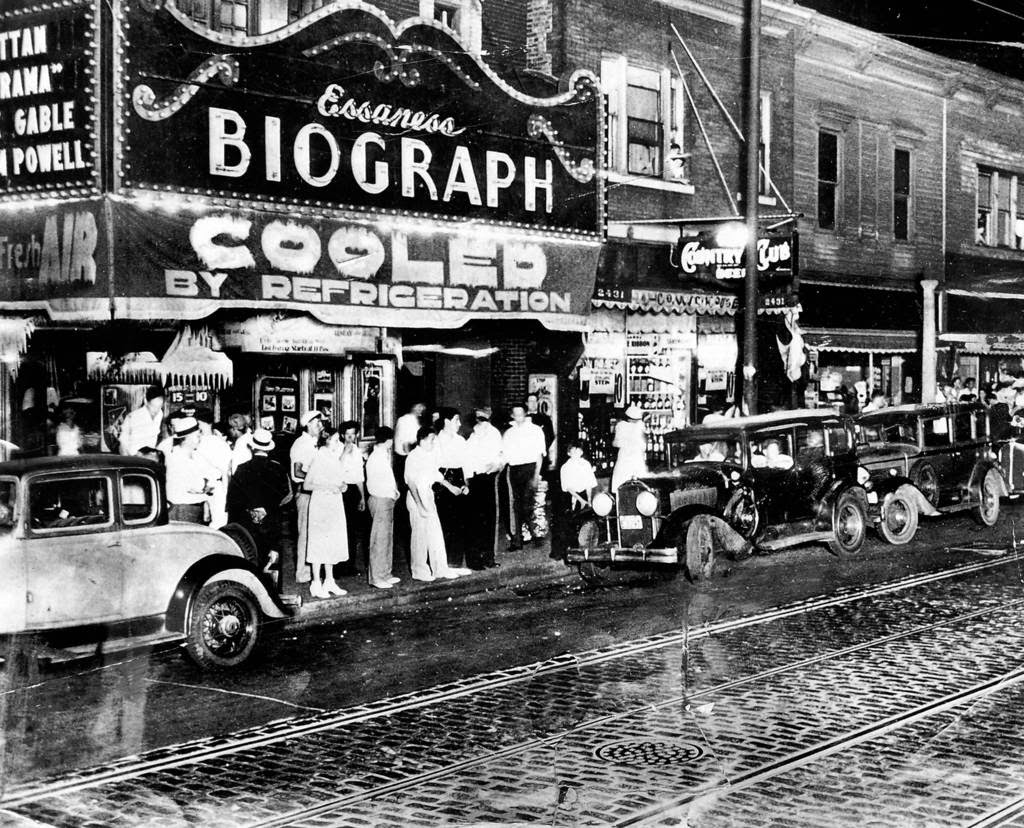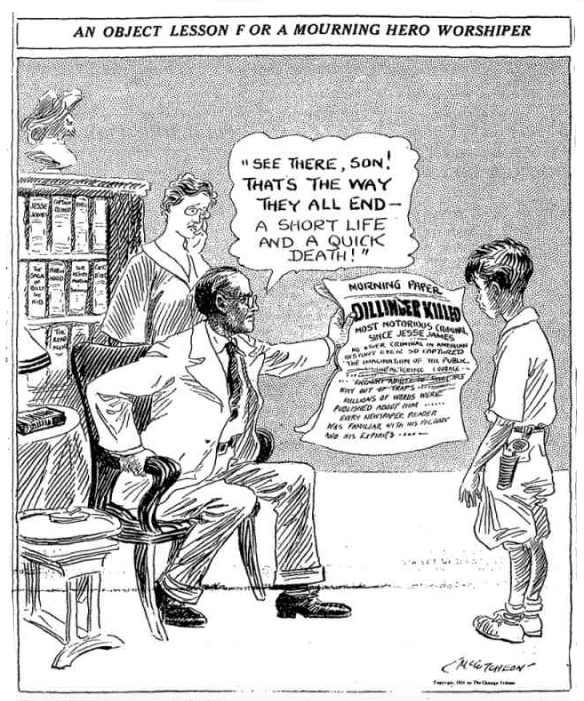Relatives to dig up Gangster John
Dillinger’s body
Gangster John Dillinger's relatives have been granted a permit dig up the bad
guy's corpse and have a coroner conduct a DNA exam on the remains of the corpse
from a cemetery in Indianapolis where he was buried there almost 70 years ago.
The family and many others believe that an imposter was buried in Dillinger’s
grave and that Dillinger escaped captured and lived for decades under another
name.
It won’t be an easy dig. The body
was is buried under five feet of concrete and steel on orders of Dillinger’s
father who was certain that someone would steal his body to sell for a hefty
profit. Old man Dillinger himself had been offered $10,000 to place John
Dillinger’s body on display. (Roughly $200,000 today)
The conspiracy theory
According to the conspiracy theorists, a petty thug named Jimmy Lawrence, who
was said to have a resemblance to Dillinger, was set up to take Dillinger’s
place and that it Lawrence who was shot in killed in an alley just to the right
of the Biograph theater. Of course the problem with that theory is that once
Lawrence was closed in on by the FBI, it would take the agents only seconds to
realize that Lawrence wasn’t Dillinger…..unless, of course, the entire plot
involved having the FBI knowingly murder Lawrence instead of Dillinger because
the Bureau had a deal that would allow Dillinger to escape and disappear
forever. Although Melvin Purvis, the special agent in charge was a flawed
fellow in many ways, it’s extremely unlikely Purvis would have opened himself
to charge of premeditated murder. Besides, Purvis wasn’t really in charge at
that point. After a spectacular and bloody goofed up raid to get Dillinger and
the Little Bohemia Lodge, FBI Director Hoover virtually lost all faith in
Purvis and a hard-nosed FBI Special Agent named Sam Crowley to oversee
Dillinger’s capture. Crowley worked alone on the case and only brought Purvis,
who was in deep trouble with Washington and on his way out of the agency when
needed.
The prolific Chicago author Jay
Robert Nash has been the primary advocate of the “Dillinger’s not dead” school
of thought. Nash and others contend that Dillinger escaped being arrested at
the Biograph Theater where the FBI, led by the diminutive legendary agent
Melvin Purvis, was waiting for him.
According to Nash, he has or had
fingerprints and photos of Dillinger as he would appear in 1960 that were
allegedly sent to Melvin Purvis just prior to his 1960 alleged suicide at his
home in South Carolina. According to Nash (more probably an accident). Nash
alleged Dillinger was living and working in California as a machinist, under
what would have been an early form of the witness protection program
(Purvis was reported to be
depressed just before his death, which was the result of the misfiring of a gun
he was cleaning. His death is not officially listed as suicide. If he did kill
himself, it was more certainly over the unsubstantiated story that he was being
blackmailed for certain behaviors more than being confronted with yet more
allegations of Dillinger not being dead.)
The actual
events in Dillinger’s death
The facts are that on July 21,
1934, the madam of a brothel in Gary, Indiana, who called herself Anna Sage
(Ana Cumpanas) called a local cop she knew ad asked him to contact the FBI on
her behalf because she had information they wanted on Dillinger. Her terms for
handing over the information were simple. She wanted a cash reward as well as
the Bureau’s help in keeping her from being deported back to her native
Rumania. Deportation proceedings had started against her at that point.
A meeting was arranged between
Sage and Special Agent Cowley. Crowley said that if her information led to
Dillinger’s arrest, she would certainly get the reward money ($5,000 cash, in
or about $100,000 today) and as for her deportation, he said that all he could
do was to inform the Department of Labor (which at that time handled
deportation matters) about her help in capturing Dillinger.
Agent Crowley
Agent Purvis
Sage agreed and told Crowley that
a girlfriend of hers, Polly Hamilton, a waitress, had dropped by a for a visit
with Dillinger, whom she recognized from a newspaper photograph and then she
offered this plan; she had arranged to take in a film with Polly Hamilton, and
Dillinger, but the theater wasn’t settled. They would either attend the
Biograph or the Marbro Theaters. Sage said she would be wearing an orange skirt
and white blouse, so that she would be easy to recognize. (In poplar legend
that later morphed into a red dress)
On Sunday, July 22, Anna Sage
called Agent Crowley to confirm plans about going to the theater, but she still
did not know which theater they would attend so Crowley sent full teams to both
the Biograph or the Marbro Theaters. On a gamble, Crowley went with the team
that was covering the Biograph.
Polly Hamilton and Anna Sage
At 8:30 p.m., Anna Sage, John
Dillinger, and Polly Hamilton walked into the Biograph Theater to see Clark
Gable in "Manhattan Melodrama."
Cowley ordered the squad sent to
the Marbro to rush over the Biograph and then phoned Hoover for instructions.
Since the theater was crowded, it was agreed that the agent would wait
(Theaters offered air condition
which very few homes had at that time and as a result, they were almost always
filled to capacity in the warmer months.)until Dillinger was outside on the
street to take him. Hoover also gave a specific order that if Dillinger, a cop
killer, offered any resistance, the agent would do whatever they had to do to
save themselves.
At 10:30 p.m., Dillinger, with
his two female companions on either side, walked out of the theater and turned
to his left. As they walked past the doorway in which Purvis was standing,
Purvis lit a cigar as a signal for the other men to close in.
Dillinger quickly realized what
was happening and a pistol from his right pant pocket as he ran toward a nearby
alley. Five shots were fired from the guns of three FBI agents. Three of the
shots hit Dillinger, and he fell face down on the pavement.
He was taken to the
Alexian Brothers Hospital and pronounced dead at 10:50 p.m. on July 22, 1934. (
14 years later gangster Roger Touhy was pronounced dead in the same room, murdered
by the mafia)
Exactly who killed Dillinger
isn’t known. What is known is that FBI agent Charles B. Winstead, Clarence O.
Hurt, and Herman E. Hollis fired their weapons, on command from Crowley, at
Dillinger.
Agent Crowley was later murdered
by gangster Baby Face Nelson in a wild shootout on November 27, 1934. Also
killed was agent Herman Hollis, one of the sharpshooters who stationed on the
roof of the Biograph Theater and the man who more than probably killed
Dillinger.
Anna Sage (Above) returned to her apartment
after the shooting and dumped Dillinger’s ample supply of ammunition left at
her house into a nearby canal. The girlfriend, Polly Hamilton, ran away from
the theater after the shooting started. She fled Chicago, but returned a short
time later, married and lived as a housewife on the North Side until her death
in 1969. Anna was paid the $5,000 reward money as promised (She said Crowley
offered her double that amount but that appears to be an out and out lie) and
Crowley did address the court on her deportation as promised but to no avail.
She was deported back to Rumania before the end of the year. She died there, of
liver disease in 1947.
Back to the
conspiracy.
The
fingerprints
The fingerprints on the corpse
supposedly didn't match Dillinger’s. Would someone in the Chicago Coroner’s
office make off with Dillinger’s prints? Sure they would. The coroner himself
admitted to stealing large parts of Dillinger’s brain to study as specimens.
Adding to this, the story was that, reportedly, while he was on the run,
Dillinger was said to have had a Doctor burn off his fingerprints with acid in
May of 1934. There is absolutely no evidence to back that story up. However,
the legend grew that the acid had little effect and Dillinger’s prints were
basically unchanged.
The reality is that Special
Agents M. Chaffetz and Earle Richmond took two sets of fingerprints from
Dillinger’s body minutes after he was gunned down outside the Biograph. Both
sets of prints matched Dillinger’s. A third set of prints was taken during the
autopsy and those prints matched Dillinger as well.
The eye
coloring
A story spread that the corpse
had brown eyes and Dillinger probably had blue eyes.
The main source of all of this
mix up falls back on the coroner’s autopsy report which went missing for 50
years until it was found by an Administrative assistant in a brown paper
shopping bag in a room adjoining the office of Dr. Robert Stein, the Cook
County Medical Examiner. The autopsy report says Dillinger's eyes were brown.
Author Jay Robert Nash said a 1923 Navy physical exam described Dillinger's
eyes as blue and the wanted poster issued by J. Edgar Hoover in March 1934 said
his eyes were gray. Adding to this is the fact that after death, there can be
some clouding of the cornea which would make identifying the actual eye color
difficult. brown. Author Jay Robert Nash said a 1923 Navy physical exam
described Dillinger's eyes as blue and the wanted poster issued by J. Edgar
Hoover in March 1934 said his eyes were gray. Adding to this is the fact that
after death, there can be some clouding of the cornea which would make
identifying the actual eye color difficult.
Heart problems
The conspiracy crown also points
out that the corpse was too tall to be Dillinger and the eye color was wrong
and the corpse possessed a rheumatic heart. and that Dillinger didn’t have any
history of heart troubles. But in fact, he did.
A Dr. Patrick H. Weeks, a
physician and psychiatrist at the Indiana State Prison in Michigan City during
the time of Dillinger's incarceration at the facility in 1938 wrote that
"During his term at the Indiana prison I was well acquainted with
Dillinger but came rarely into contact with him in my professional capacity.
The lad from Mooresville was not a hospital pest; that is, he was not one of
those prisoners who need medical treatment upon the slightest provocation
whatsoever. I examined him two or three times, however, and discovered
something about his physical condition, which is quite surprising and which,
incidentally, was never revealed in the press. John Dillinger suffered from
heart disease. He had a distinct heart lesion. The disease was organic. I told
Dillinger that he should never subject himself to great mental or physical
strain because it might hasten his death. I was confident that he would follow
my advice."



Much was made out of the fact
that neither Dillinger’s long-suffering father nor Dillinger’s sister Audrey
believed the corpse was John Dillinger. In fact, the newspapers made a lot of
hay out of Dillinger's father's only words upon identifying the body
"That's not my boy."
There were three reasons he may
not have been able to identify his son. One was that the corpse was bloated
because it had been exposed to severe summer temperatures and rough handling
inside the overcrowded morgue. Secondly, when Dillinger ran for it down an
alley when the FBI closed in, two FBI agents who were stationed on the roof of
the theater and a nearby garage (Since town down and replaced) fired downward,
piercing Dillinger’s face causing the blood clotted open wounds on this face
that the press (Without a trace of truth) described as "scars resulting
from inept plastic surgery".
Audrey changed her mind when she
and E.F. Harvey of the Harvey Funeral Home located the scar on the back of
Dillinger's thigh which he suffered jumping over a barbed-wire fence as a boy.
The disinterment of whoever the
hell is in the grave is planned for December 31, 2019.















